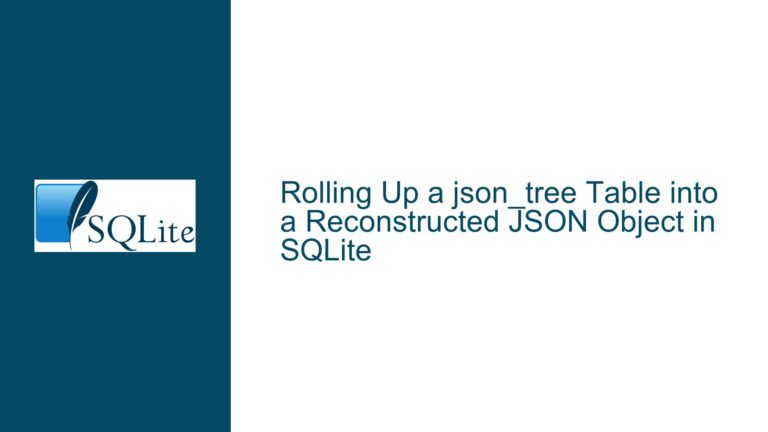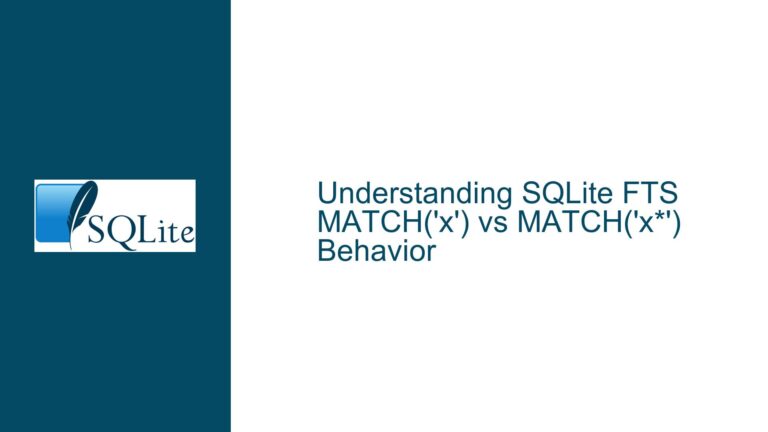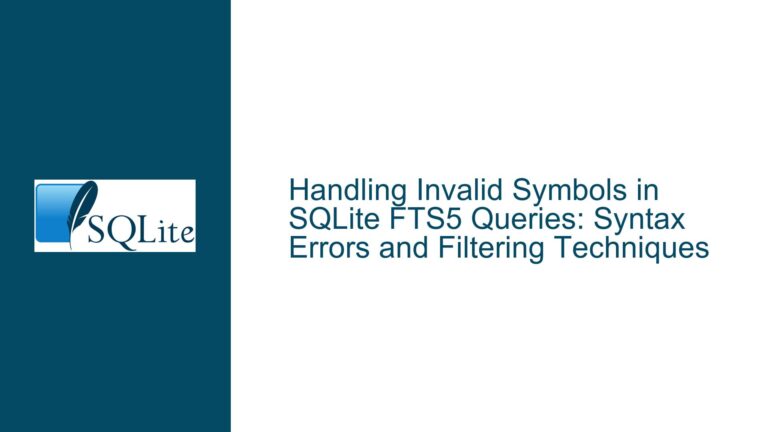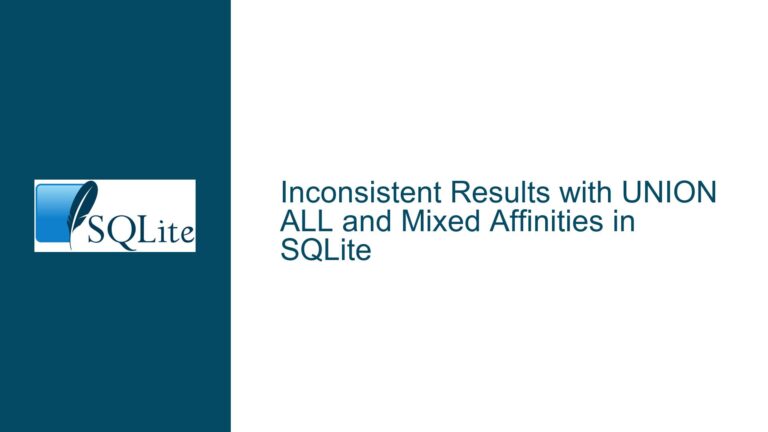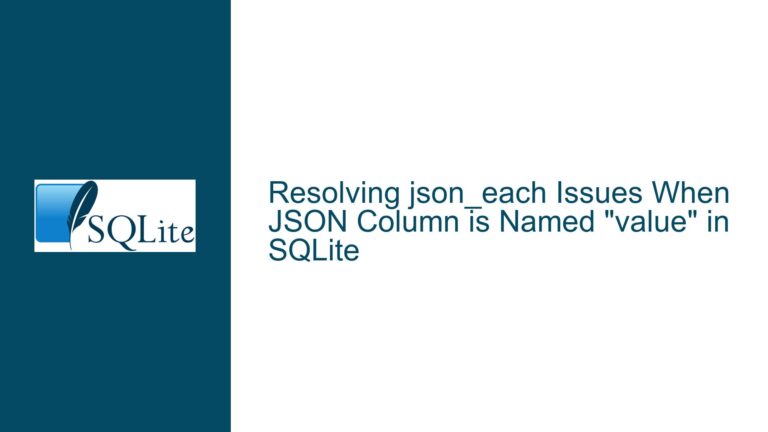Parsing Non-ISO Date Strings from XML Attributes in SQLite
Extracting and Formatting Variable-Length Date-Time Strings Embedded in XML Attributes for Sorting
Parsing Challenges with Non-Standard Date Formats and XML Attribute Extraction
The core challenge revolves around extracting date-time values stored within XML attributes in a SQLite database column and converting them into a sortable format. The date strings follow a non-ISO 8601 pattern (Sat Apr 22 1:01:51.887), omitting the year and using variable-length components for day and hour. The XML structure complicates extraction because attribute order is not guaranteed, and the date string’s position within the XML tag cannot be assumed static. Three fundamental issues converge here:
- Non-Standard Date Format: The absence of year information and inconsistent padding for single-digit days/hours prevents direct conversion to ISO 8601.
- XML Attribute Position Dependency: Reliance on substring positions assumes fixed attribute order, which violates XML’s flexibility.
- Ambiguity in Time Component Parsing: Variable-length time components (e.g.,
1:01:51.887vs.12:01:51.846) require dynamic handling to avoid misalignment during extraction.
The desired output requires appending the current year (assumed by the user) and reformatting the date components into YYYY-MM-DD HH:MM:SS.SSS. This must be achieved without native XML parsing support in SQLite, forcing reliance on string manipulation functions. The fragility of substring-based parsing becomes apparent when considering edge cases like single-digit days (Apr 2 vs. Apr 22) or hours (1:01 vs. 12:01), which shift substring offsets. Additionally, the lack of year in the source data introduces implicit dependencies on runtime context (e.g., current year), requiring careful handling to avoid silent data corruption.
Fragile Substring Parsing, XML Structure Assumptions, and Missing Year Context
1. Substring Position Sensitivity
The initial approach uses SUBSTR(xml_tag, 18, 3) to extract the month abbreviation, assuming the time attribute always starts at position 18. This breaks if:
- Attributes are reordered (e.g.,
type="Debug"appears beforetime="..."). - The weekday abbreviation (
Sat,Sun) varies in length (though fixed at 3 characters in English). - The XML tag includes namespaces or additional attributes, altering the relative position of
time.
Example of attribute reordering breaking substring logic:
<Event type="Debug" time="Sat Apr 22 1:01:51.887" ...>
Here, time starts at position 21, rendering SUBSTR(xml_tag, 18, 3) invalid.
2. Variable-Length Date and Time Components
The day (22 vs. 2) and hour (1 vs. 12) components lack leading zeros, causing substring offsets to shift. For instance:
Apr 22 1:01:51.887has the hour at position 25.Apr 2 12:01:51.887shifts the hour to position 24.
This necessitates conditional logic to detect single/double-digit values and adjust offsets dynamically—a non-trivial task in SQLite’s limited string function set.
3. Implicit Year Assumption and Timezone Ambiguity
Assuming the current year via STRFTIME('%Y') introduces hidden dependencies:
- Logs spanning December and January will incorrectly assign years if not processed in real-time.
- Historical data from previous years becomes unmanageable without explicit year storage.
- Timezone differences between log generation and processing may misalign dates.
4. Inadequate XML Parsing in SQLite
SQLite lacks built-in XML parsing functions, forcing developers to treat XML as plain text. This makes attribute extraction error-prone and tightly coupled to the XML’s textual representation rather than its logical structure.
Robust Extraction Methods, Preprocessing Strategies, and Schema Redesign
Step 1: Immediate Fixes Using SQL String Manipulation (With Caveats)
For scenarios where preprocessing isn’t feasible, use a combination of SUBSTR, INSTR, and CASE statements to handle variable-length components.
Modified Query Handling Single/Double-Digit Days and Hours:
WITH cte(xml_tag) AS (VALUES
('<Event time="Sat Apr 2 1:01:51.887" ...'),
('<Event time="Mon Feb 22 12:01:51.883" ...'))
SELECT
STRFTIME('%Y') || '-' ||
CASE SUBSTR(xml_tag, INSTR(xml_tag, 'time="') + 6, 3)
WHEN 'Jan' THEN '01' WHEN 'Feb' THEN '02'
-- ... other months ...
ELSE '??' END
|| '-' ||
-- Extract day, handling single/double digits:
CASE
WHEN SUBSTR(xml_tag, INSTR(xml_tag, 'time="') + 10, 1) = ' '
THEN '0' || SUBSTR(xml_tag, INSTR(xml_tag, 'time="') + 9, 1)
ELSE SUBSTR(xml_tag, INSTR(xml_tag, 'time="') + 9, 2)
END
|| ' ' ||
-- Extract time, handling single/double-digit hours:
CASE
WHEN SUBSTR(xml_tag, INSTR(xml_tag, 'time="') + 12, 2) LIKE '%:%'
THEN '0' || SUBSTR(xml_tag, INSTR(xml_tag, 'time="') + 12, 8)
ELSE SUBSTR(xml_tag, INSTR(xml_tag, 'time="') + 12, 8)
END
|| SUBSTR(xml_tag, INSTR(xml_tag, 'time="') + 20, 4)
AS event_time
FROM cte;
Key Improvements:
- Uses
INSTRto locatetime="dynamically, reducing dependency on fixed positions. - Conditionally pads days/hours with leading zeros using
CASEandLIKE.
Limitations:
- Fails if the
timeattribute contains spaces (e.g.,time = "..."with spaces). - Assumes time format is
HH:MM:SS.SSSafter the day.
Step 2: Preprocess XML with External Scripts for Robustness
For reliable extraction, preprocess the XML outside SQLite using a language with proper XML support (Python, Perl, etc.).
Python Preprocessing Script:
import sqlite3
from xml.etree.ElementTree import fromstring
from datetime import datetime
conn = sqlite3.connect('logs.db')
cursor = conn.cursor()
# Create normalized table
cursor.execute('''
CREATE TABLE IF NOT EXISTS parsed_events (
event_time TEXT,
type TEXT,
thread TEXT,
elapsed INTEGER,
function TEXT,
code TEXT
)
''')
# Extract and transform XML from raw table
cursor.execute('SELECT xml_tag FROM raw_events')
for (xml_str,) in cursor.fetchall():
# Wrap in root element for proper parsing
root = fromstring(f'<root>{xml_str}</root>')
event = root.find('Event')
time_str = event.get('time')
# Parse date, assuming current year
dt = datetime.strptime(time_str, '%a %b %d %H:%M:%S.%f').replace(year=2023)
# Insert into normalized table
cursor.execute('''
INSERT INTO parsed_events
VALUES (?, ?, ?, ?, ?, ?)
''', (
dt.isoformat(),
event.get('type'),
event.get('thread'),
int(event.get('elapsed')),
event.get('function'),
event.get('code')
))
conn.commit()
conn.close()
Advantages:
- Handles XML attribute order changes.
- Properly parses variable-length days/hours via
datetime.strptime. - Decouples data cleaning from querying, improving performance.
Step 3: Schema Redesign to Enforce ISO 8601 and Avoid XML Storage
Advocate for schema changes to store dates natively in ISO 8601 format, eliminating parsing complexity:
Recommended Table Structure:
CREATE TABLE events (
event_time TEXT, -- ISO 8601: '2023-04-22T01:01:51.887'
type TEXT,
thread TEXT,
elapsed INTEGER,
function TEXT,
code TEXT
);
Migration Strategy:
- Batch Conversion: Use preprocessing scripts to convert existing XML logs into
INSERTstatements with ISO dates. - Application-Level Fixes: Modify the logging framework to emit ISO 8601 dates directly.
- Database Constraints: Add
CHECKconstraints to validate incoming dates:ALTER TABLE events ADD CHECK (event_time GLOB '????-??-??T??:??:??.???Z');
Step 4: Handling Legacy Systems Resistant to Change
For systems where XML format cannot be altered, implement a hybrid approach:
1. Virtual Columns with JSON Extensions:
Use SQLite’s JSON1 extension to store extracted dates in a virtual column:
ALTER TABLE raw_events
ADD COLUMN event_time TEXT
GENERATED ALWAYS AS (
json_extract(
xml_tag,
'$.Event.@time'
)
);
2. Trigger-Based Normalization:
Create triggers to auto-populate a normalized date column on insert:
CREATE TRIGGER normalize_event_time
AFTER INSERT ON raw_events
BEGIN
UPDATE raw_events
SET event_time =
strftime('%Y') || '-' ||
CASE substr(json_extract(xml_tag, '$.Event.@time'), 5, 3)
WHEN 'Jan' THEN '01'
-- ... other months ...
END || '-' ||
substr(json_extract(xml_tag, '$.Event.@time'), 9, 2) || ' ' ||
substr(json_extract(xml_tag, '$.Event.@time'), 12, 12)
WHERE rowid = NEW.rowid;
END;
Step 5: Mitigating Year Assumption Risks
To address the implicit current year assumption:
- Log Metadata Extraction: Store log file creation dates in a separate column and derive the year from filenames or metadata.
- Heuristic Year Detection: Use adjacent timestamps to infer the year when logs span December/January.
WITH dated_logs AS (
SELECT
xml_tag,
LAG(event_time) OVER (ORDER BY event_time) AS prev_time
FROM raw_events
)
SELECT
CASE
WHEN prev_time LIKE '%-12-%' AND event_time LIKE '%-01-%'
THEN strftime('%Y', prev_time, '+1 year')
ELSE strftime('%Y')
END AS inferred_year
FROM dated_logs;
Final Recommendations
- Avoid XML/Text Hybrid Storage: Store dates, times, and other structured data in normalized columns.
- Preprocess Non-Standard Formats: Use external scripts for robust parsing before data reaches SQLite.
- Leverage SQLite’s Flexibility Sparingly: While possible, complex string manipulation in SQL should be a last resort.
- Advocate for ISO 8601 Compliance: Push upstream systems to adopt standardized date formats, simplifying storage and querying.
By combining cautious substring parsing, preprocessing, and schema redesign, developers can transform fragile XML-embedded dates into sortable, query-friendly timestamps while mitigating the risks of positional dependency and format ambiguity.

